Spelunking: A Deck Report and Brewing History
12/17/2023
At RC Atlanta this past weekend, three members of the Sanctum for All testing team (me, cftsoc, and Will Miller) registered Spelunking Combo. We did pretty well, if not amazingly - me and cft both made day 2 with our Yorion BTL list, though cft dropped from 6-4 and I only ended up going 8-5-1 total, and Will was 4-0 with their 60-card Beseech list before scrubbing out at 5-4.
So, similar to what I did with RataBlade, in this article I'm going to go over most of what I know about Spelunking. I'll talk about how the combo works, the history of various builds of it we tried, and how we landed on the build we submitted.
Part 1: How the Combo Works
The Core Loop
The easiest place to start with is the ending loop. There are a few variations of it, but the core is pretty simple: with
Spelunking in play cast Splendid Reclamation to return Mystic Sanctuary, two Lotus Field, any land that sacrifices itself to draw a card, and any other one land.Definition - Drawland
Throughout this article, I'm going to refer to a "drawland" as any land that sacrifices itself to draw a card. Some examples of this include
Roadside Reliquary, ONE spheres like The Dross Pits, and LCI caves like Hidden Volcano.Since Spelunking causes all the lands to enter untapped, Mystic Sanctuary triggers, and you can tap all the lands except the drawland for 8 mana. So, you can put Reclamation back on top with Sanctuary, sacrifice all but the drawland to Lotus triggers, and use that mana to draw Reclamation and recast it. As long as it takes 3 or less mana to draw Sanctuary, you net mana each time, getting infinite mana.
a video demonstration of the core loop
Converting to a Kill
There's many ways you can kill from this spot. Of course, any infinite mana outlet like
Cut to Ribbons kills. Any land that does anything can also be inserted into the loop very easily - Gingerbread Cabin makes infinite food and thus infinite life, Sunscorched Desert or Ramunap Ruins can ping your opponent infinite times, and a second drawland can draw your deck.A second Mystic Sanctuary and a second drawland can also work together to loop any instant or sorcery - after you make infinite mana, you can start putting both Reclamation and another spell on top, draw both, and cast both - this turns something like
Kolaghan's Command in your hand or graveyard into a kill.a video demonstration of a double Mystic Sanctuary loop
Sidenote: Comboing Online
Sadly, it is pretty hard to make use of the double Sanctuary loop online - it just takes too much time to make that much mana, and also takes extra loops on top of that to slowly ping them down with Kolaghan's Command.
Cut to Ribbons is probably the only viable online kill, and it can still take upwards of 7 minutes to combo on MTGO.How Did We Get Here?
Of course, getting four specific lands in the graveyard is pretty hard (2 Lotus, 1 Sanctuary, 1 drawland). It could theoretically happen naturally, but ideally we would be able to assemble this easily. So how do we do that?
Enter
Scapeshift, a classic lands combo card. You might notice that, like for Reclamation, the lands you get off of Scapeshift enter untapped. So, with 4 lands in play, you can Scapeshift for Lotus, Lotus, Sanctuary, and a drawland; float mana; sacrifice the lands; and then cast Reclamation to start looping.This brings the combo down to a 3 card combo - Spelunking in play, Scapeshift and Reclamation in hand. But we can do better! What if Scapeshift and Reclamation were just one card?
Enter
Beseech the Mirror and Bring to Light. Both are sorceries that can tutor for and cast Scapeshift. Scapeshift can then find Mystic Sanctuary and a drawland, putting the tutor back on top and drawing it again. Finally, that lets you tutor for and cast Reclamation.With these tutors, the combo is now just two cards: with Spelunking in play, cast either Beseech the Mirror or Bring to Light. So, let's talk about some full combo lines, and what they look like.
Part 2: Full Combo Outlines
Basically all the full combo lines will look like the following, with a few details changed:
- 1. Spelunking in play, cast tutor, find and cast Scapeshift.
- 2. Scapeshift for Lotus, Sanctuary, drawland. Put tutor on top and draw it.
- 3. Cast tutor, find and cast Reclamation.
- 4. Reclamation brings back Lotus, Sanctuary, drawland. Put Scapeshift on top and draw it.
- 5. Scapeshift for second Sanctuary, second Lotus, second drawland. Put Reclamation on top and draw it.
- 6. Loop for infinite mana, then use tutor to find a kill; with double Sanctuary you can use any spell.
Some example lines in specific:
Beseech Combo (Spelunking, 4 lands, 1 bargain fodder):
- 1. Cast bargained Beseech, find and cast Scapeshift.
- 2. Scapeshift for Lotus, Sanctuary, Gingerbread Cabin, and Hidden Necropolis (any cave works). Tap all but the cave for 5 mana, sacrifice Lotus and Sanctuary to Lotus trigger, make a food, and put Beseech on top.
- 3. Sacrifice the cave using 5 mana to cast Beseech, bargaining away the food, find and cast Reclamation.
- 4. Reclamation brings back Lotus, Sanctuary, cave, and four lands. Tap non-cave lands for 8 mana, sacrifice Lotus and Sanctuary to Lotus trigger, put Scapeshift on top.
- 5. Sacrifice the cave using 5 mana to cast Scapeshift, sacrificing five lands. Get second Sanctuary, second Lotus, second drawland, and two other lands. Float mana, sacrifice Lotus and Sanctuary to Lotus trigger, and put Reclamation on top.
- 6. Sacrifice cave to cast Reclamation, start looping.
a video demonstration of Beseech combo on 4 lands with 1 bargain fodder
Beseech Combo (Spelunking, 3 lands including Lotus, 2 bargain fodder):
- 1. Cast bargained Beseech (floating 1 mana), find and cast Scapeshift.
- 2. Scapeshift for Lotus, Sanctuary, and Hidden Necropolis (any cave works). Tap all but the cave for 4 mana (5 total now), sacrifice Lotus and Sanctuary to Lotus trigger, and put Beseech on top.
- 3. Sacrifice the cave using 5 mana to cast Beseech, bargaining away second fodder, find and cast Reclamation.
- 4. Reclamation brings back Lotus, Lotus, Sanctuary, cave, and two lands. Tap non-cave lands for 9 mana, sacrifice all but cave and one Lotus, put Reclamation on top.
- 5. Sacrifice the cave using 5 mana to cast Reclamation (4 mana left), getting back Lotus, Sanctuary, cave, and two lands. Tap non-cave lands for 6 mana (up to 10), sacrifice Lotus and Sanctuary to Lotus trigger, put Scapeshift on top.
- 6. Sacrifice the cave using 5 mana to cast Scapeshift (5 mana left), sacrificing three lands to get second Sanctuary, third Lotus, and second drawland. Tap for mana, sacrifice Lotus and Sanctuary, put Reclamation on top.
- 6. Draw and cast Reclamation, start looping.
a video demonstration of Beseech combo on 3 lands including Lotus with 2 bargain fodder
Sidenote: Caves
The LCI caves are a weird but nice form of drawland. They have a couple downsides - notably, you can't use them as much with BTL, since BTL costs 5 mana and they only discover 4; and you can only use them sorcery speed, so you can't, for example, get Lotus, Lotus, Sanctuary, cave with 4 lands, as then the Lotuses force you to sacrifice the cave before you can use it.
However, they are arguably the best drawland for the Beseech lines for one simple reason: they cost 1 mana to draw a card, instead of 2 (as you spend 5 mana to discover into your 4 cost spell). Almost every other drawland either costs 2+ mana (Roadside Reliquary and ONE Spheres), and the only one that costs 1 has an annoying restriction (
Cryptic Caves doesn't let you combo on low land count).So, the LCI caves are the only lands that let you combo with Beseech on 4 lands 1 bargain, or 3 lands 1 lotus 2 bargain. Just another example of how the discover mechanic is broken :D
(And, of course, they have one final upside: if you put a cave into play with Spelunking, you gain 4 life!)
BTL Combo (Spelunking, 5 lands):
- 1. Cast BTL for four colors, find and cast Scapeshift.
- 2. Scapeshift for Lotus, Lotus, Sanctuary, drawland, and any other land. Tap all but the drawland for 8 mana of four colors, sacrifice all but drawland to Lotus triggers, and put BTL on top.
- 3. Draw and cast BTL for four colors, find and cast Reclamation.
- 4. Reclamation brings back Lotus, Lotus, Sanctuary, drawland, and six lands. Tap for mana, sacrifice for lands, put Scapeshift on top.
- 5. Draw and cast Scapeshift, sacrificing five lands to find second Sanctuary, third Lotus, second drawland, and two other lands. Tap for mana, sacrifice Lotus and Sanctuary to Lotus trigger, put Reclamation on top.
- 6. Draw and cast Reclamation, start looping.
Sidenote: Combo Edge Cases
One weird part of this combo is that it has a staggering amount of edge cases that can theoretically come up when you draw combo lands. For example, if you have one of your two Mystic Sanctuaries in hand and want to go for the double Sanctuary loop to kill, you have to be able to work in playing the Sanctuary at some point, and might need to figure out when the right time is. A similar thing can happen with wanting to play Lotus Field after a Scapeshift and not before, so that you get to tutor more lands.
Another common one is having already drawn or played Gingerbread Cabin in Beseech lines - be careful to keep track of whether Scapeshift can fetch bargain fodder.
A really fun one is trying to play around Field of Ruin - both in that it forces a shuffle and in that it can kill your cave with no window to use it. The trick is just to have another instant speed draw source (another drawland or even just a triome in hand to cycle).
I personally don't think it's that hard to derive combo lines from first principles as long as you understand the general goal of the combo (which, hopefully, you do now that I've explained it). But also people look at me like I'm deranged, so YMMV. I don't think I have the time or space to go through everything I can think of in that much detail here.
Part 3: The Cutting Room Floor
The process for brewing brand new decks is always a messy one. In the course of exploring spelunking, we tried many different builds, many of which had some glaring problems. Here's some examples of decks we thought weren't good enough:
Turbo Beseech Spelunking
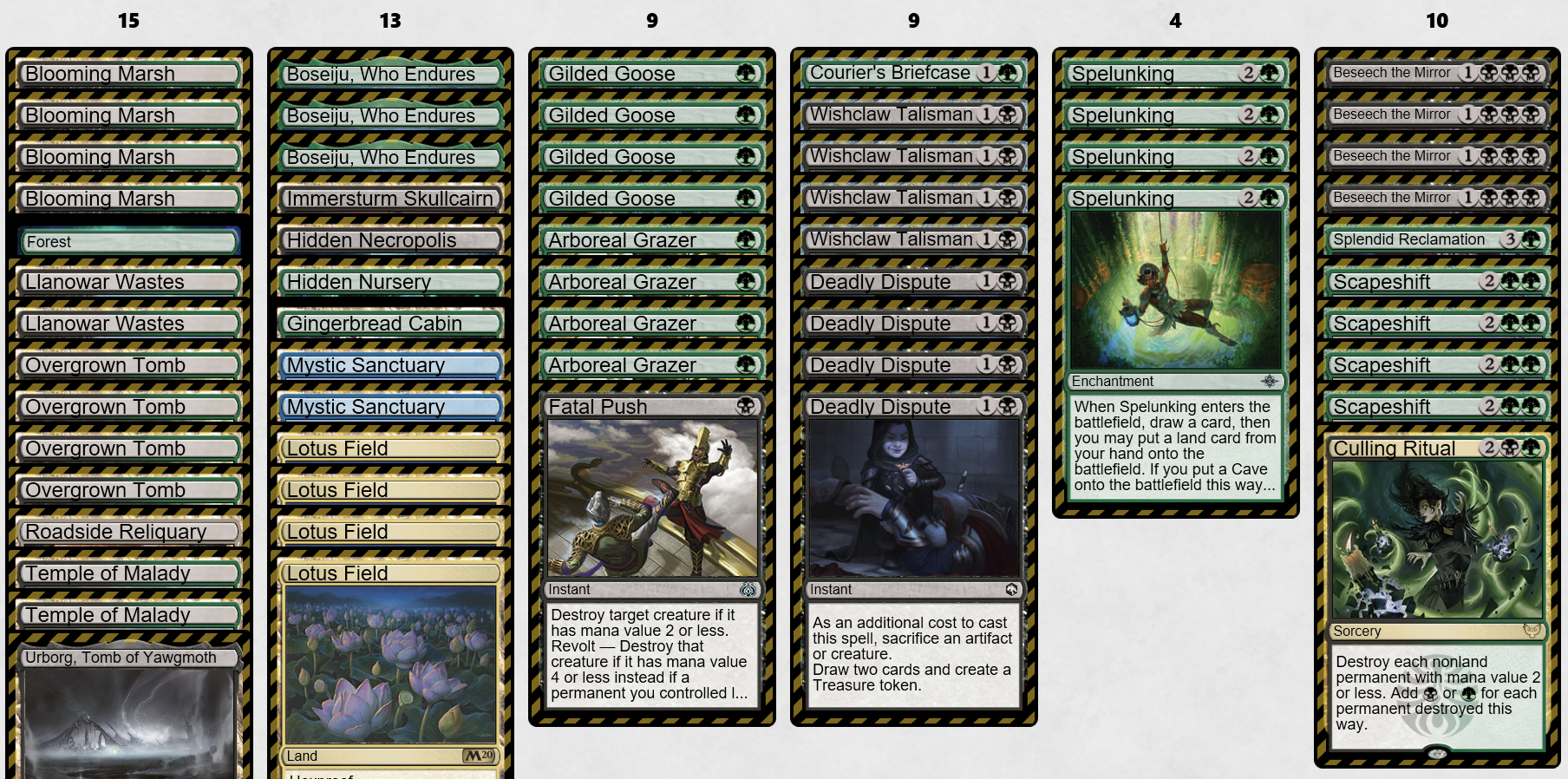
Turbo Beseech Spelunking
The idea with this deck is to just try to combo as fast as possible, with little consideration for much else. Thus, we're running multiple copies of Scapeshift, so that we don't need to draw Beseech to win.
Arboreal Grazer speeds us up, Wishclaw Talisman finds our pieces, and Deadly Dispute lets us turn both of those into bargain fodder. Culling Ritual is mostly just a nice wrath you can get with Wishclaw for value.The problem with this build is mostly just that it's not fast or resilient enough. You're about as fast as Lotus Field combo (turn 4 usually, turn 3 with Grazers), and maybe a bit more consistent, but also much more vulnerable to interaction. There aren't many redundant pieces, so Thoughtseize on a Spelunking or Beseech can really slow you down. And of course, any interaction with Spelunking or graveyard hate just stops your combo cold in its tracks.
Jund Transmog Beseech Spelunking
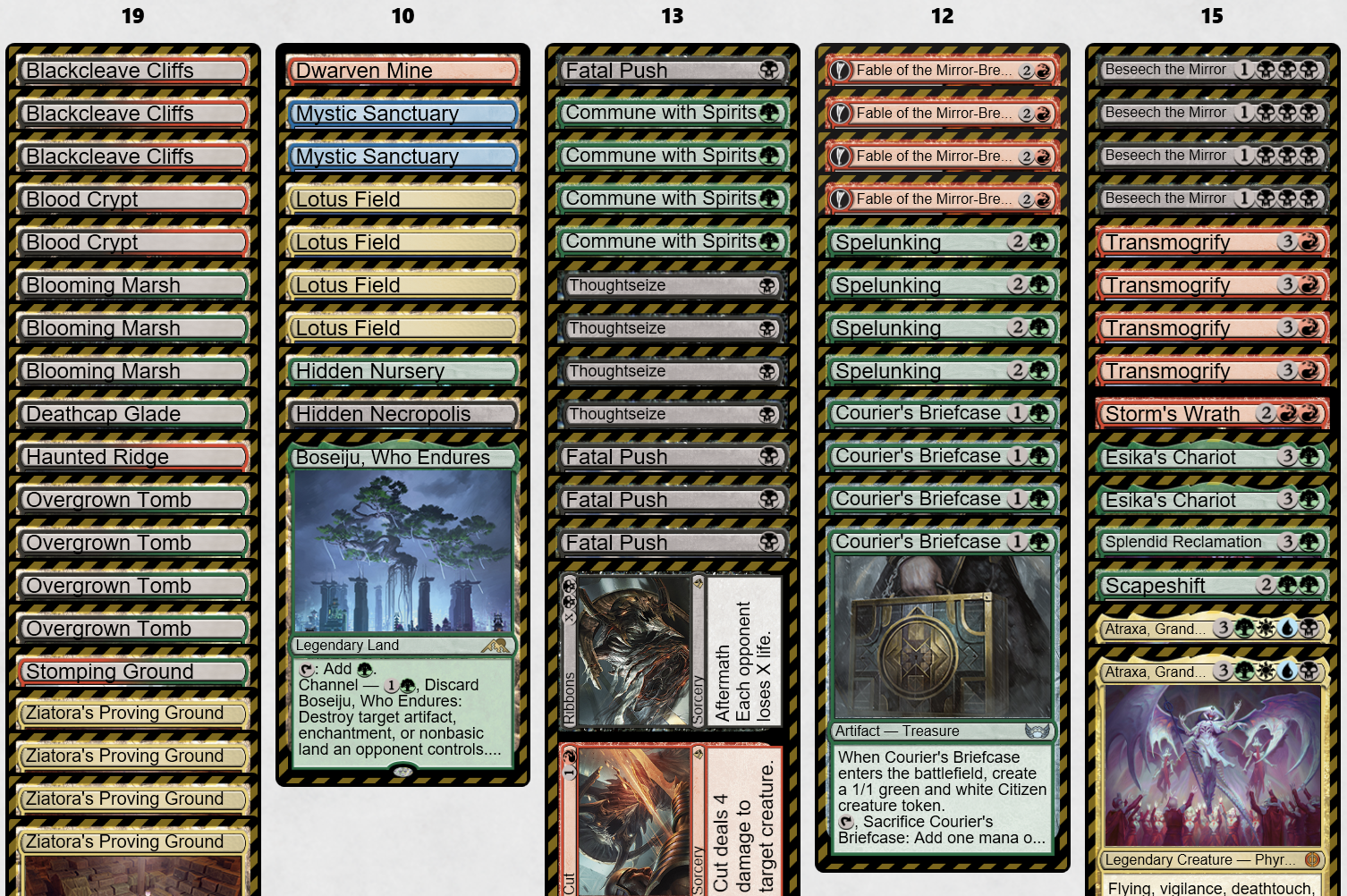
Jund Transmog Beseech Spelunking
Jund
Transmogrify was one of the first shells we tried, with the idea being that wanting tokens for Transmog lined up nicely with wanting bargain fodder for Beseech, and you can also Beseech for Transmog in some spots. We generally built this with >60 cards, as there are a lot of cards we would rather not draw and leave in our deck ( Atraxa, Grand Unifier and all the combo lands).The problem was, Transmog just isn't really the best plan to pair with Spelunking. The two plans have a bit too much overlap, with both relying on resolving a 4 mana sorcery such that they didn't really complement each other so much as lose to the same things.
Sultai Beseech Spelunking
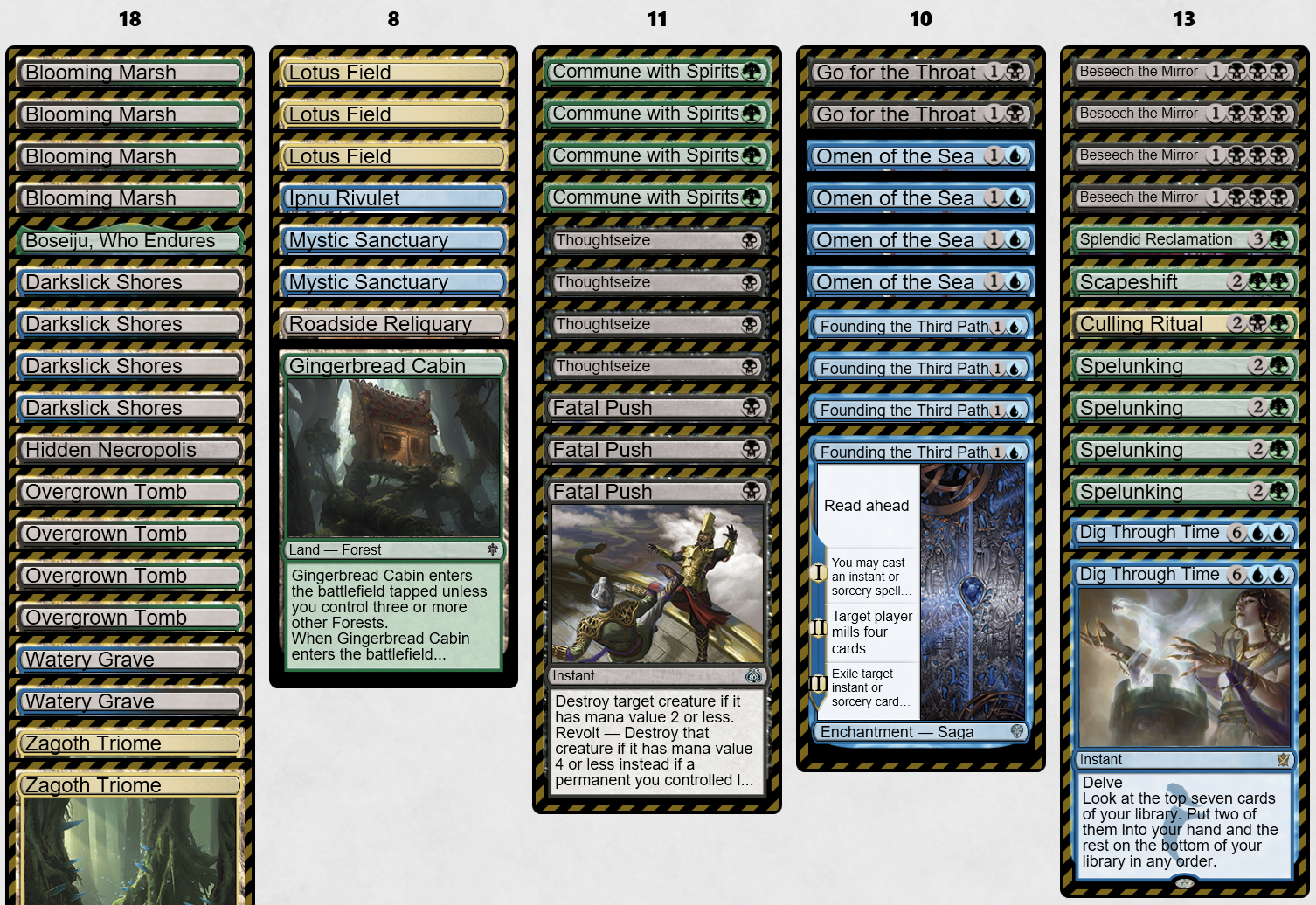
Sultai Beseech Spelunking
The genesis of this deck was me lamenting that our jund builds didn't have great ways to find Beseech, and then remembering that
Omen of the Sea and Founding the Third Path exist. I think this deck actually competes with the turbo deck in combo consistency and speed while also having more interaction, but one glaring issue is that graveyard hate not only turns off the combo but also turns off Founding. Also, while it can interact, it can't really win except through the combo - it doesn't really have a midrange plan.Theoretical Abzan Beseech Spelunking
Over the course of brewing, we considered playing white in Beseech for
Leyline Binding, Temporary Lockdown, and sideboard Rest in Peace (since you can bargain it to Beseech). However, we never really landed in a place we liked enough to actually have a decklist ready for playing with, as the mana just seemed really rough, and Fable of the Mirror-Breaker seemed way too mandatory.Part 4: Treacherous Blessing and Jund
One of the most important developments during our brewing and testing was finding the
Treacherous Blessing package in Jund.The idea is that Treacherous Blessing is very powerful bargain fodder - it's one of the only cards that is both good rate and something you're just happy to bargain away. Then, along with Fable and Spelunking, you have enough enchantments that
Commune with Spirits becomes a powerful cantrip. Red also gives you Torch the Tower to make sure you don't die to your own Blessings.We fiddled around a lot with various versions of this deck. Will's deck was a version of it - you can find their writeup here.
It certainly is powerful - you can play a decent midrange plan with Fables and
Esika's Chariot, and you can threaten to combo pretty consistently in 60 cards. But as testing went on I never really found a Jund Beseech version I really liked - the problem was just that I felt it didn't quite play the midrange plan well against decks that didn't care that much about Chariot.For a while, cft was on a Yorion version of Jund Spelunking that also added
Bonecrusher Giant. The theory was that 80 cards made the mana more consistent, not less, as you get to dilute your combo lands. But I also didn't love that, as I felt you sacrificed too much combo consistency for not much midrange power, and just had more variance in general from being a Yorion deck.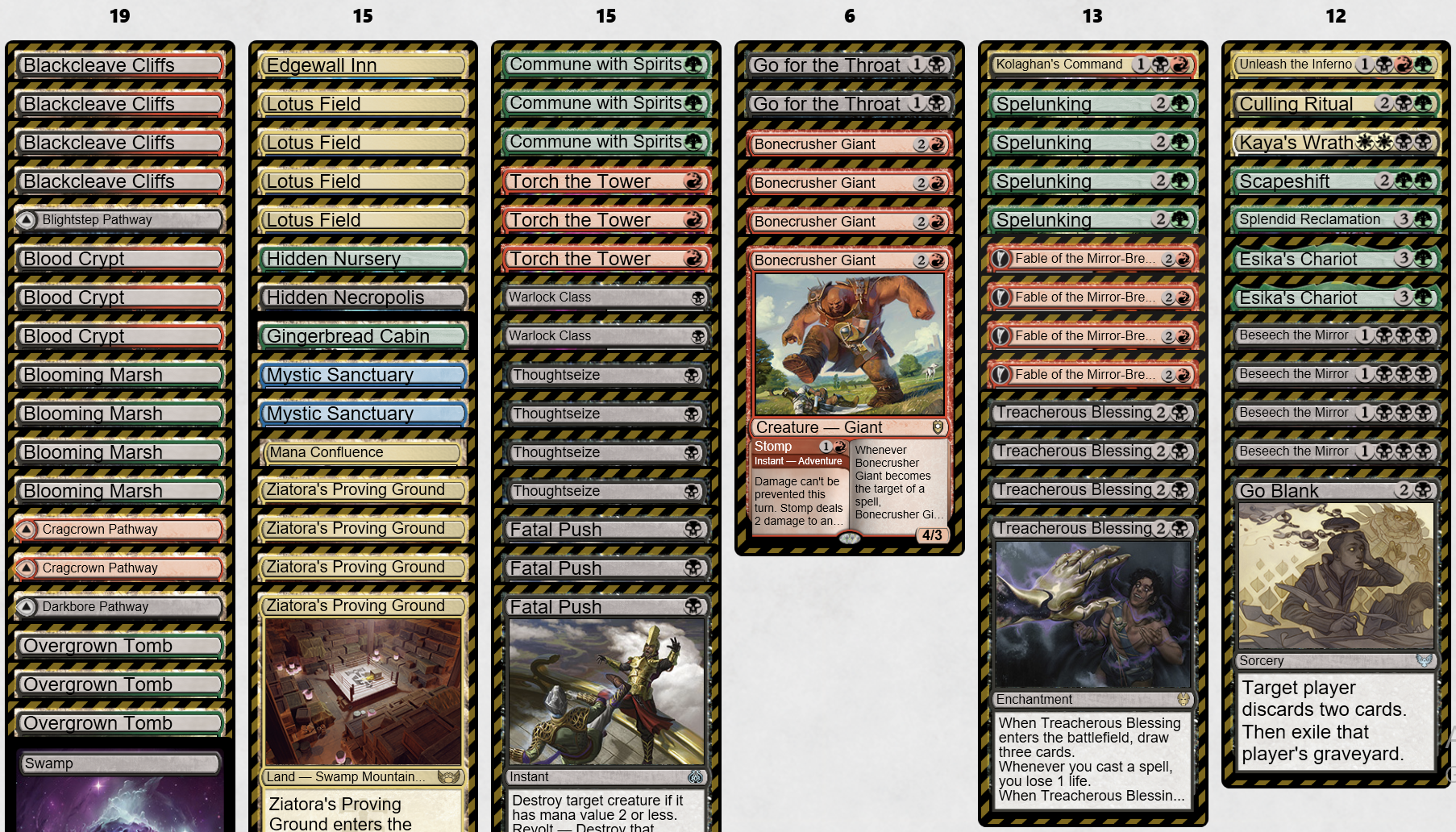
a Jund Yorion Beseech Spelunking list; the Warlock Classes are questionable and were one of the last things we were trying out
Part 5: Bring to Light
You might notice that most of what I've been talking about so far has involved Beseech the Mirror, and notably hasn't really touched on Bring to Light. Well, that's simply because that was where the vast majority of our testing went - cft and I only started brewing our final BTL list on Monday, four days before deck submission!
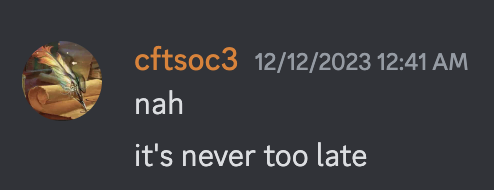
cft on Monday night, four days before deck submission, in response to to the question 'do you think it's too late to be building BTL'
So why hadn't we been considering BTL much before then, and why did we switch?
A More Awkward Combo
The big reason we had discounted BTL early was because of how much more awkward it was to combo with it. Beseech can combo off of 4 lands, or 3 lands including Lotus - BTL increases those land counts by 1 across the board. The reason for this is that both your tutor and your drawland cost 1 more mana, as LCI caves can "draw" Beseech for effectively 1 mana, compared to ONE spheres drawing BTL for 2.
Since comboing generally involves casting the tutor twice and using the drawland once before you become unconstrained on mana, this adds a 3 mana tax on top of what you need for Beseech, which generally translates to 1-2 extra lands needed. It's nice that you don't need bargain fodder, but on the flip side you also need to care more about having distinct colors of mana.
And speaking of colors of mana - the BTL converge requirement also punishes you for playing Lotus Fields, as Lotus can only tap for three mana of one color. 3 lands including a Lotus can make 5 mana, but it can't cast BTL for Scapeshift!
However, it turns out this just isn't that big of a deal. Yes, it can slow you down a turn, but so can not having bargain fodder for Beseech. And yeah, Lotus making BTL for 4 harder, but you only need 3 colors for
your wrath and 2 colors for Tibalt!And, once we thought about it a bit, we realized we could alleviate some of the combo difficulty by just including one copy of Beseech! You can BTL for Beseech, then cast Beseech with bargain for Scapeshift, and just use that as your tutor for Reclamation - instead of needing 3 extra mana, you only need 1, which is a lot more workable. Plus, it just introduces a fifth copy of that combo piece to the deck, helping with consistency.
A More Powerful Midgame
In the end, the thing that drew us back to BTL was just Bring to Light as a card. cft and I came to the conclusion that Beseech just sadly wasn't quite a good enough card at playing the midrange game - it could get some nice tools, but it was really hard to make it take over the game except by comboing, especially when you had to bargain something away.
In comparison, Bring to Light getting
Tibalt is just such a huge payoff, so much better than anything Beseech can get. It's a card that singlehandedly wins midrange games if not answered, absolutely crushing rakmid decks.The mana isn't the cleanest in the world, but I managed to put together something workable.
Sylvan Caryatid helps a lot here; a classic combo with using BTL for Deadly Vanity.Tuning the Combo
There was still one problem to face: the combo wasn't very consistent. Without the Treacherous Blessing package, and with Caryatids taking up mana source slots, it really wasn't feasible to play Commune with Spirits still to find Spelunking. Yorion certainly didn't help on that angle, but was basically mandatory to fit a playable manabase and interaction suite alongside combo lands and BTL targets.
But, finally, we found the missing piece that convinced me to actually register the deck over Amalia:
Wandering Mind. Digging 6 deep is so much, and being a Fable copy target and a Yorion blink target is just icing on the cake. I'm still not sure how many copies you want, but it helped so much with assembling the combo, and with just finding BTL for the fair game too.Part 6: The List
First of all, I want to preface this by saying that the list we registered registered is somewhat but not heavily tuned. We spent a lot of time brewing Spelunking as a whole, but again, the actual final deck came together in 4 days. We had a good foundation, but we didn't get that much time for true focus testing.
That said, here's the list:
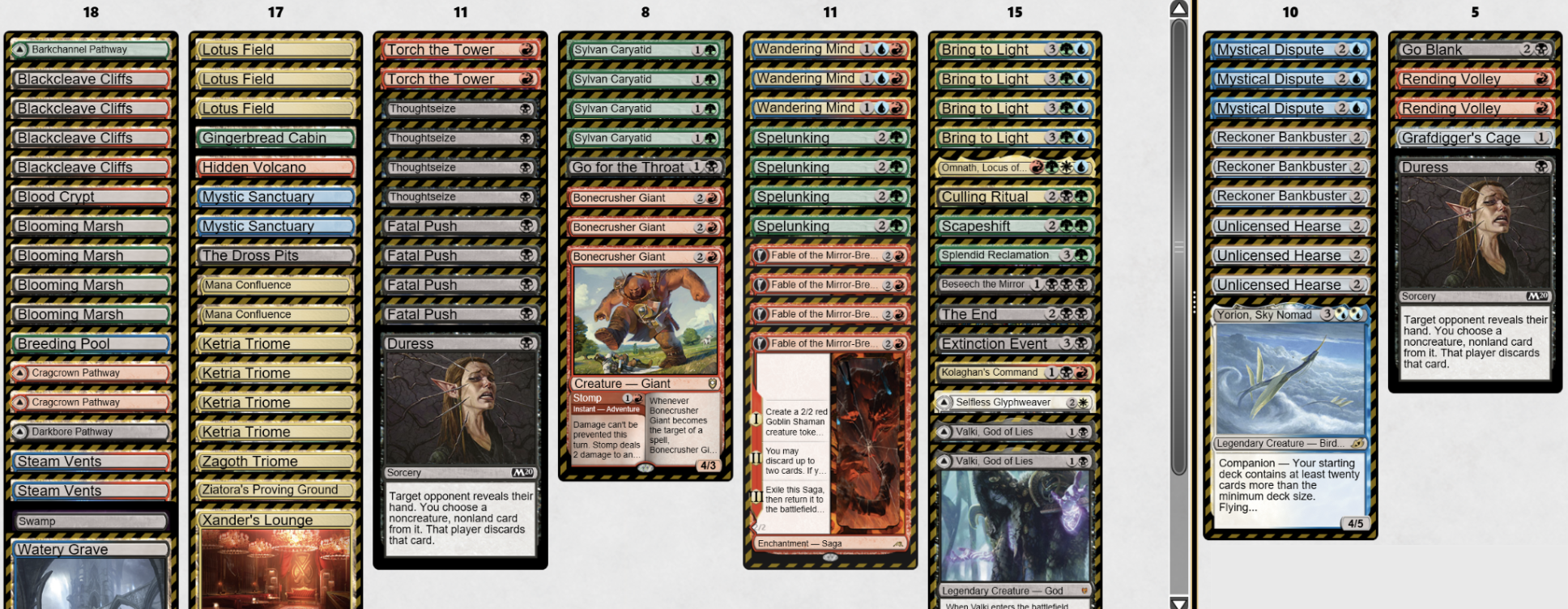
the list I registered for RC Atlanta
I believe the only difference between my list and cft's list is that they registered one
Tear Asunder and one Cavalier of Thorns over one Rending Volley and one Duress.Card Choices - The Toolbox
Valki and Glyphweaver are pretty standard BTL targets - a threat that takes over the game, and a somewhat one-sided wrath.
Omnath, Locus of Creation is nice for stabilizing life total, and turns Spelunkings into rituals amusingly.Scapeshift, Reclamation, and Beseech are for the combo. Notably, even though you can't BTL for Spelunking, you can theoretically BTL for Beseech for Spelunking - I did this once during the tournament.
Extinction Event exists for Phoenix and Amalia. The End is almost entirely for Amalia. Culling Ritual is a lot less powerful here than in Jund Beseech, but it's still quite a powerful effect when it lines up right and can sweep away hate like Rest in Peace and Damping Sphere
Kolaghan's Command exists to kill with the double Sanctuary loop while also being a playable midrange card.
Card Choices - The Interaction
It's possible this deck could forgo being base black. But the
Thoughtseize Fatal Push interaction package just lines up so well into so much of this format, most notably against Amalia. Plus, Thoughtseize is just nice for being able to push BTL through counterspells.Bonecrusher Giant is very much a cft card. I'm definitely lower on it than them, though I admit it's pretty good. I'm not convinced it's absolutely essential to this deck, but it does its job.
Torch the Tower and Go for the Throat are mostly here to fill space. Torch might be an overreaction to Amalia, but we just didn't really have any better ideas for what to put there, and just wanted more cheap interaction.
Part 7: Matchups and Sideboarding
Again, I want to stress that we didn't get to do nearly as much focus testing as I would've wanted due to time pressure. But still, I can give some notes on various matchups we planned out. I'll try to give ballpark estimates on how good each matchup is as well, but again, take it all with a big grain of small-sample-size salt.
Rakdos Variants
This includes various forms of Rakdos, from stock RakMid, to Inti Copter, to RakSac.
I think all of them are pretty favorable, at least 65% I'd say, just because, outside of hand disruption, they have roughly no way to interact with Spelunking and BTL.
In (3): 3 Reckoner Bankbuster
Out (3): 3 out of the 4 of: 1 Duress, 1 The End, 1 Extinction Event, 1 Swamp (maybe also Culling Ritual against stock RakMid)
Phoenix
This was the matchup we tested the most by far, and it's a tricky one. I think we got it to somewhere pretty close to 50% with a lot of sideboard respect. It would be nice to have a cleaner mapping, though, and this might be over-boarding.
In (13): 3 Reckoner Bankbuster, 3 Unlicensed Hearse, 3 Mystical Dispute, 2 Rending Volley, 1 Go Blank, 1 Duress
Out (13): 1 Valki, 1 Glyphweaver, 1 Omnath, 3 Bonecrusher, 1 Fatal Push, 1 Kolaghan's Command, 2 Torch, 1 Culling Ritual, 1 The End, 1 Swamp
Basically, the idea is that the games tend to come down to counterspells on BTL, so
Reckoner Bankbuster, Mystical Dispute, and hand disruption are really good. Plus, there are just a lot of bad cards to take out. Note that Kolaghan's Command is not necessary because Phoenix can't beat gaining infinite life with Gingerbread Cabin.Amalia
I think this is a very favorable matchup, something like 70-75%. We just have enough early disruption to prevent the combo, a way to exile the combo forever, and a combo of our own to close the door before their anemic beats can kill.
I will note that I have never played against the Knight-Errant version of Amalia, and that might be a lot scarier.
In (4): 1 Grafdigger's Cage, 2 Rending Volley, 1 Go Blank
Out (4): 1 Omnath, 1 Kolaghan's Command, 1 Duress, 1 card based on vibes that I never figured out
Convoke
I think this is an okay matchup, probably somewhere in the 50-60% range, but I'd have to test it more to be sure.
In (4): 2 Rending Volley
Out (4): 1 The End, 1 Duress
UW Control
I really wish we had the time or foresight to test against this matchup more. I think right now it's something like a 40-45% matchup, but I also think that could be fixed with some thought put into it.
In (8): 3 Reckoner Bankbuster, 1 Duress, 3 Mystical Dispute, 1 Go Blank
Out (8): 2 Sylvan Caryatid, 4 Fatal Push, 1 Extinction Event, 1 Culling Ritual
Lotus Field Combo
I really don't know what to think of this matchup. I thought it was going to be pretty bad but ignorable, but then I ended up getting paired against it twice in the tournament and winning both matches. More testing needed.
In (10): 3 Reckoner Bankbuster, 3 Mystical Dispute, 2 Unlicensed Hearse, 1 Duress, 1 Go Blank
Out (10): 4 Fatal Push, 1 Go for the Throat, 2 Torch the Tower, 1 Glyphweaver, 1 Extinction Event, 1 Culling Ritual
Notably this is more taking out blank cards than putting in good cards lol.
UW Spirits
I really didn't expect my sideboard notes on spirits of all things to be relevant, but I did in fact face it twice in the tournament. I think it's a pretty bad matchup, somewhere near 40%. The only reason I even had notes for it was because it was one of the few matchups I think you should just board out the combo.
In (9): 3 Reckoner Bankbuster, 3 Mystical Dispute, 2 Rending Volley, 1 Duress
Out (9): 4 Spelunking, 2 Lotus Field, 1 Scapeshift, 1 Splendid Reclamation, 1 Kolaghan's Command
Notably this is more taking out blank cards than putting in good cards lol.
Part 8: Future Work
All in all, I'm very happy with my deck choice for the event. 8-5-1 is pretty respectable for a brew cobbled together 4 days before the event, and I think I even got a very unfavorable set of opponents. I somehow ran into 2 UW spirits opponents and 4 UW control opponents; I had just as many UW opponents as I had Rakdos (2), Phoenix (1), Amalia (1), and Convoke opponents combined.
I don't think that Spelunking can really be "broken" in the current format. It's just a bit too constrained and clunky in a few ways - the mana is a bit sketchy, Yorion is a bit high variance, and just beinga bit slow sometimes. You can certainly mitigate these to some extent, but I'd be pretty surprised if it were ever a clear best deck.
However, I do think that it has very real legs. If you could find a way to tune the phoenix matchup to be just a tiny bit better, and find a way to address the UW control matchup, suddenly the matchup spread starts looking really good.
I'm not saying I'm going to be registering Spelunking for PT Chicago. I suspect I'm actually quite unlikely to. But I'm certainly going to see how much further I can take it.
#FreePalestine | Consider donating to UNWRA or PCRF, supporting protesters locally, and educating yourself.
